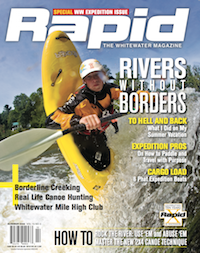Lasy fall I rode my first ever conveyer belt to the top of the river. It was so intriguing I rode dozens of times. I was riding on a dream, the dream of every long-time whitewater boater. “Dude, what we need is a river that goes in a circle and we end up back where we started.” But none of us dudes ever thought it would happen, nor did we consider what it would do to the sport.
The fifth annual Whitewater Symposium was held in McHenry, Maryland, home of Adventure Sports Center International and America’s newest and most technologically advanced circular river.
The Whitewater Symposium is a gathering of like-minded river professionals who come together on a yearly basis to plan the future of the sport. Many see these whitewater parks as the saving grace of declining participation. They say they are the climbing gyms of whitewater.
The theory goes that more climbers on safe and attainable plywood walls morphs into more climbers on rock. More climbers on rock leads to a healthier industry and stronger stewardship organizations like the Alpine Club, or in our case American Whitewater.
There was plenty of talk like this at the Whitewater Symposium. But no one had the answer to my big question, Is this true? Do more gym climbers lead to a healthier rock climbing industry and community?
Afterward, I called David Chaundy-Smart, the editor of Gripped, a magazine similar to Rapid but for climbing. The similarities and growing pains of the two activities are strikingly similar and his advice about what to expect from whitewater parks was simple: “be prepared for massive change.”
Paddling, like climbing, has traditionally been made up of guys like me—a homogenous group of white, outdoorsy men sworn in to the fraternity by like-minded, scruffy-bearded brothers. We learned the hard way. Long drives, frigid swims, blackflies and hiking out after dark were just part of the adventure and the culture. And for the most part we liked it that way. Whitewater grew slowly.
Climbing gyms and whitewater parks on the other hand distill everything that is fun about the sport, taking away the unpleasant stuff like risk and personal discomfort. At the ASCI course you can be on the water right after dinner, paddle a few circuits on the sweetest waves and be back in the chalet slamming gin and tonics by eight-thirty.
Do climbing gyms create more climbing enthusiasts and environmental stewards? David thinks yes, but not the way you might expect.
He estimates that a big climbing gym in a major city puts 300 new climbers in harnesses every week. Fifteen years ago that number would have been true for the region’s entire outdoor climbing season. That one gym would introduce 15,000 people to climbing a year. Even if only three per cent of those become climbing enthusiasts—the type who climb outside on real rock—that’s 450 new core climbers coming out of one gym, every year.
Whitewater Parks are Rivers Without Borders
This trickle-down, small percentage of the bigger number appeals to me most. This issue of Rapid we’ve called “Rivers Without Borders,” and in a way whitewater parks are rivers without borders. Parks open the floodgates so wide virtually anyone can try whitewater. We’ll have a wider, healthier cross-section of paddling enthusiasts including some who’ll bring their gangster rap persona to the river, but also soccer moms and soccer teams, steel workers, lawyers, environmentalists and politicians—people with money and power.
Some of them will buy a lifetime family membership to the Action Sports Center. I hope others will take their $5,000 and give it to American Whitewater for the preservation and access of real rivers, so they’ll run free longer than just our lifetime.




